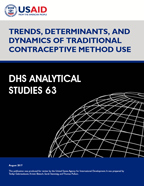
Abstract:
Millions of women worldwide use a traditional
method of family planning for fertility
regulation. As global family planning
dialogue has shifted to focus on modern
method users only, the contemporary
literature
about family planning is largely silent on
traditional method use. However, evidence
from qualitative studies indicates that some
women—even those who have access to modern
methods — have a distinct preference for
traditional methods. This study investigates
levels and trends of traditional method use,
multiple traditional methods and simultaneous
modern and traditional method use; and
discontinuation and switching in countries
with at least five Demographic and Health
Surveys (DHS). Data come from DHS surveys
from the early 1990s to present in 16
countries—Bangladesh, Colombia, the Dominican
Republic, Egypt, Ghana, Indonesia, Jordan,
Kenya, Malawi, Peru, the Philippines, Rwanda,
Senegal, Tanzania, Zambia, and Zimbabwe. The
analysis includes currently married women age
15-49.
This report also includes case studies of
four countries—Peru, Jordan, Indonesia, and
Ghana—chosen by patterns of contraceptive
use. We examine changes in the contraceptive
method mix and run a series of binary
logistic regressions to investigate the
changing importance of different
sociodemographic characteristics in the use
of any method (modern versus traditional),
traditional versus modern methods (among
contraceptive users), and withdrawal versus
periodic abstinence (among traditional method
users).
In most countries in this study, married
women over age 35, with five or more
children, those who want no more children,
those with more education, and urban
residents have generally higher levels of use
of traditional methods than their
counterparts. The analysis by wealth quintile
indicates two distinct patterns.
In some countries, traditional method use is
more common among richer women, while in
others, women in the low quintiles who are
poorer are more likely to use traditional
methods. Findings from the multivariate
analyses for the four countries in the case
studies illustrate that much of the
high level of traditional method use found in
the descriptive analysis was driven by
certain groups of women’s higher overall
contraceptive use. When restricted to
contraceptive users, many of these groups
(the more educated and those who want no more
children) were more likely to use modern than
traditional methods.
The analysis of contraceptive discontinuation
indicates that in 15 of the 16 countries,
over 25% of women stopped using a modern
method because of health concerns or side
effects. In contrast, fewer than 2% of users
of traditional methods discontinued for the
same reason. Overall, traditional method
users in the majority of countries in this
study have lower discontinuation and
switching rates compared with modern method
users.
Traditional methods have two key
disadvantages compared with modern methods.
First, they are less effective and second,
the two most popular traditional methods
(withdrawal and periodic abstinence) require
cooperation of the male partner. However,
these methods continue to play a role in the
lives of millions of women. We recommend a
two-pronged policy strategy, one that ensures
traditional method users are aware of more
effective modern methods that can be used
covertly, and —consistent with a rightsbased
approach to family planning—one that also
does not completely exclude traditional
method users from the opportunity to obtain
respectful support and education about their
method of choice.
 Trends, Determinants, and Dynamics of Traditional Contraceptive Method Use (PDF, 1623K)
Trends, Determinants, and Dynamics of Traditional Contraceptive Method Use (PDF, 1623K)
